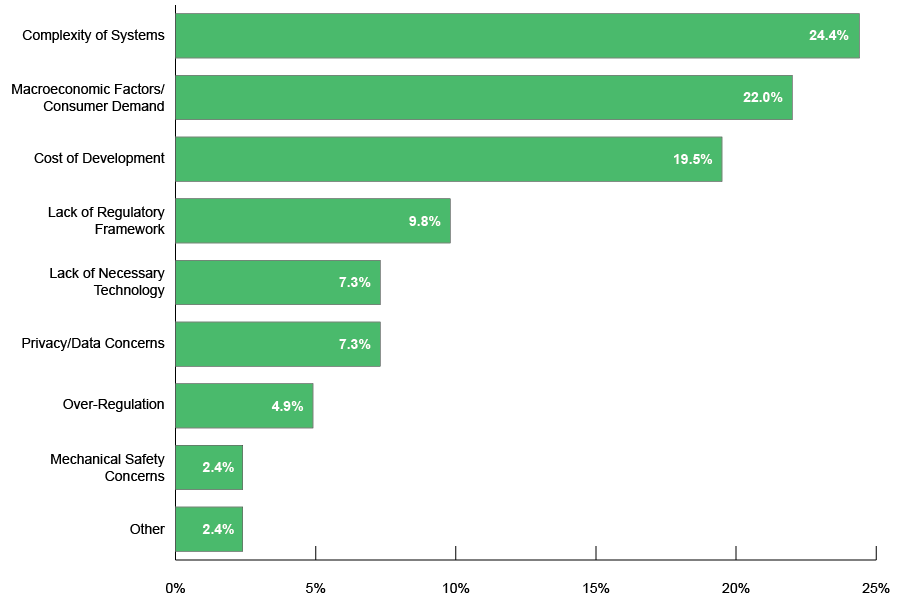IoT & Embedded Technology Blog
AUTOSAR Adaptive & Classic Critical for Modern Automotive Software Development
by Paige Ludl | 11/16/2022
Software development will be a key battleground for the automotive industry in order to support the push towards autonomous vehicles (AV). A focus on automation, connectivity, electrification and sharing will drive automotive trends forward and significantly influence software development. A standard software architecture is necessary for mitigating the largest obstacle to the development and growth of the connected vehicle industry, which is the complexity of automotive systems (see Exhibit 1). AUTomotive Open System ARchitecture (AUTOSAR) Classic has been a critical standard for manufacturers and suppliers since 2003, as it that allows reuse of software assets to optimize productivity in software development. Emerging technology to suit AV trends has led to the development of a new standard, AUTOSAR Adaptive. Software development solution providers need to incorporate both of these standards into their offerings to remain at the forefront of automotive software development.
Exhibit 1: Biggest Obstacles to the Development and Growth of the Connected Vehicle Industry
(Percentage of Respondents)

History of AUTOSAR Classic
AUTOSAR Classic is a software architecture designed to support standardization in the automotive industry to address the rise in electronic control units (ECUs). Prior to AUTOSAR, vehicle manufactures had to specify what was required for their ECU systems to suppliers, which caused them to design many similar but different specifications and offerings. The development of in-vehicle electronics was becoming more complicated and expensive, but the structure provided by AUTOSAR Classic allowed developers to re-use software instead of continually re-developing similar software components. Companies that currently offer AUTOSAR-compliant products like operating systems or developer toolsets include a variety of embedded software leaders, such as Elektrobit, eSOL, and ETAS.
Emerging Technologies and AUTOSAR Adaptive
The need for AUTOSAR Adaptive mainly came from two new advancements for vehicle technology: High Performance Embedded Computing (HPEC) Platforms and Automotive Ethernet. HPEC platforms are used in modern vehicles to process high volumes of data required to support new functionalities, such as in modern advanced driver-assistance systems (ADAS). ADAS solutions must continuously analyze their environment via various connected cameras and sensors. ADAS by nature requires continual updating as it interacts with a constantly changing environment. Software on automotive HPEC platforms are also able to support external communication, unlike ECU software that is deployed onto static hardware.
In addition to hardware processing architectures, communication systems within vehicles need to improve to transfer growing volumes of automotive data. Ethernet is able to achieve the communication needed to process data streams for sophisticated ADAS and AV functionality, whereas technologies such as CAN, LIN, and FlexRay are unable to match. AUTOSAR Classic is unable to support or best utilize these modern automotive processing and communication systems, hence the development of AUTOSAR Adaptive.
Key Differences
AUTOSAR Classic and AUTOSAR Adaptive have fundamental differences that enable them to best support different subsystems. One major difference is that AUTOSAR Classic defines an operating system, whereas AUTOSAR Adaptive only defines an Operative System Interface and an execution context. AUTOSAR Classic was designed with the assumption that applications would require minimal updates in the future, and any ECU software updates must be done in a workshop. AUTOSAR Adaptive is able to facilitate over the air updates as it supports communication with external components. As a result, AUTOSAR Adaptive is more dynamic and offers the flexibility needed for complex systems (of systems).
The Future: AUTOSAR Adaptive and Classic Working Together
It may seem to some that AUTOSAR Adaptive is intended as a replacement to Classic. However, this is not the case. AUTOSAR Classic is best suited for embedded ECUs while Adaptive will support HPEC platforms and communication with external resources. Traditional ECUs will still be used in new cars to support basic functions such as engine control and airbag control, and AUTOSAR Classic is still best suited for these systems (at least for now). AUTOSAR Adaptive will be used for over-the-air updates, (multi-)sensor processing, infotainment and other applications. Software vendors with offerings for both Classic and Adaptive standards, such as dSPACE and Vector, are in a prime position to support modern automotive software development ahead of their competitors. The combination of these standards provides the best solution for automotive software to run efficiently and to save on development costs.
VDC’s upcoming report, “Next-Gen Automotive & AUTOSAR Adaptive Development Solutions” will provide deeper insights for automotive software development for software developers and providers to OEMs.